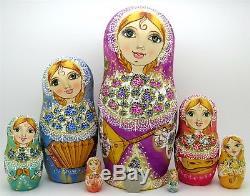
- Homepage
- Doll Size
- Ethnicity
- Item Length
- Material
- Set Includes
- Type
- Art Doll (2)
- Artist Doll (5)
- Boxes / Trinkets (3)
- Charm(s) (12)
- Collectible Gift (2)
- Doll (24)
- Dolls (4)
- Duvet Cover (2)
- Fashion (5)
- Hand Painted (21)
- Lacquer Box (16)
- Nesting (326)
- Nesting Doll (653)
- Nesting Dolls (3)
- Russian (7)
- Russian Dolls (30)
- See Description (2)
- Set (4)
- Standard (3)
- ... (4073)
Russian Matryoshka nesting dolls MATT 7 MUSIC Accordion Balalaika Gusly LARGE







This is a beautiful and unique set of 7. HAND PAINTED Russian nesting dolls signed by the Artist Khakhalina. This set is finished in MATT!! Height of the biggest doll is 24.5 cm (9 5/8 inches). The balalaika is a Russian stringed musical instrument with a characteristic triangular body and three strings. The balalaika family of instruments includes instruments of various sizes, from the highest-pitched to the lowest: the piccolo balalaika, prima balalaika, secunda balalaika, alto balalaika, bass balalaika, and contrabass balalaika. The prima balalaika is the most common.
All have three-sided bodies; spruce, evergreen, or fir tops; and backs made of three to nine wooden sections (usually maple). They are typically strung with three strings. The prima balalaika, secunda and alto are played either with the fingers or a plectrum (pick), depending on the music being played, and the bass and contrabass (equipped with extension legs that rest on the floor) are played with leather plectra.
The rare piccolo instrument is usually played with a pick. Accordions (from 19th-century German Akkordion, from Akkord - "musical chord, concord of sounds") are a family of box-shaped musical instruments of the bellows-driven free-reed aerophone type, colloquially referred to as a squeezebox.A person who plays the accordion is called an accordionist. The concertina and bandoneón are related; the harmoniumand American reed organ are in the same family. The instrument is played by compressing or expanding the bellows while pressing buttons or keys, causing valves, calledpallets, to open, which allow air to flow across strips of brass or steel, called reeds, that vibrate to produce sound inside the body.
The performer normally plays the melody on buttons or keys on the right-hand manual, and theaccompaniment, consisting of bass and pre-set chord buttons, on the left-hand manual. The accordion is widely spread across the world. In some countries (for example Brazil, Colombia and Mexico) it is used in popular music (for example Forró, Sertanejo and B-Pop in Brazil), whereas in other regions (such as Europe, North America and other countries in South America) it tends to be more used for dance-pop and folk music and as well as in regional and is often used in folk music in Europe, North America and South America. Nevertheless, in Europe and North America, some popular music acts also make use of the instrument. Additionally, the accordion is also used incajun, zydeco, jazz music and in both solo and orchestra performances of classical music.
The piano accordion is the official city instrument of San Francisco, California. The oldest name for this group of instruments is harmonika, from the Greek harmonikos, meaning harmonic, musical. Today, native versions of the name accordion are more common.
These names refer to the type of accordion patented by Cyrill Demian, which concerned "automatically coupled chords on the bass side". Its exact history is unknown. It may have derived from a. Which in turn derived from the ancient.It has its relatives throughout the world. It is also related to such ancient instruments as Chinese. Which has a thousand-year history and its Japanese relative. F/ is a small, high-pitched, transverse flute, that is similar to the piccolo, but louder and shriller due to its narrower bore. The fife originated in medieval Europe and is often used in military and marching bands.
Someone who plays the fife is called a fifer. The word fife comes from the German Pfeife, or pipe, which comes from the Latin wordpipare. The fife is a simple instrument usually consisting of a tube with 6 finger holes, and diatonically tuned.Some have 10 or 11 holes for added chromatics. The fife also has an embouchure hole, across which the player blows, and a cork or plug inside the tube just above the embouchure hole.
Some nineteenth-century fifes had a key pressed by the little finger of the right hand in place of a seventh finger hole. Fifes are made mostly of wood: grenadilla, rosewood, mopane, pink ivory, cocobolo, boxwood and other dense woods are superior; maple and persimmon are inferior but often used. Some Caribbean music makes use of bamboo fifes.Military and marching fifes have metal reinforcing bands around the ends to protect them from damage. These bands are called ferrules. Fifes used in less strenuous conditions sometimes have a lathe-turned, knob-like decoration at the ends for similar reasons. Some fifes are entirely made of metal or plastic.
Some modern fifes are of two-piece construction with a sliding tuning joint similar to some recorders. Spoons are often used in ethnic Russian music and are known as lozhki. The use of spoons for music dating at least from the 18th century (and probably older). Typically, three or more wooden spoons are used.The convex surfaces of the bowls are struck together in different ways. For example, two spoons are held by their handles in the left hand, and the third, held in the right hand, is used to hit the two spoons in the left hand. The hit, in a sliding motion, produces a typical sound. One can also hold three spoons in the left hand and put a fourth into the bot or the pocket.
A fifth spoon is then held in the right hand and used to hit the other four. Finally, one can hold the bowl of a single spoon in the left hand and hit it with another spoon. In this style, different sounds can be emitted by holding the bowl more or less tightly.
These wooden spoons are commonly used in performances of Russian folk music and sometimes even in Russian orchestras. A video of a choir performing a Russian folk song with spoon and balalaika accompaniment can be found below. These dolls are creations of a very skilled and passionate artist who has developed his own style which is both unique and traditional. Five of those dolls are painted different colours and holding music instruments.
These sets are truly beautiful works of art, finished all round to the highest standard by one of the very best artists in Russia. I also have similar sets by this Artist in my shop!
A must have for Russian doll collector. Ideal OOAK GIFT for your special ones, especially Russian Enthusiasts! All my dolls fit inside one another!! We speak French, English, German and Russian. Please leave feedback once you have received the item so that i know it has arrived safely.I will leave feedback in return. Smoke & Pet Free Item.
Powered by SixBit's eCommerce Solution. The item "Russian Matryoshka nesting dolls MATT 7 MUSIC Accordion Balalaika Gusly LARGE" is in sale since Wednesday, May 30, 2018. This item is in the category "Dolls & Bears\Dolls, Clothing & Accessories\Russian Dolls".
The seller is "tom3burma" and is located in Norwich. This item can be shipped worldwide.
- Country/Region of Manufacture: Russian Federation
- Number of Pieces: 7
- Doll Size: 9 in.
- Features: Artist Made
- Brand: Handmade

